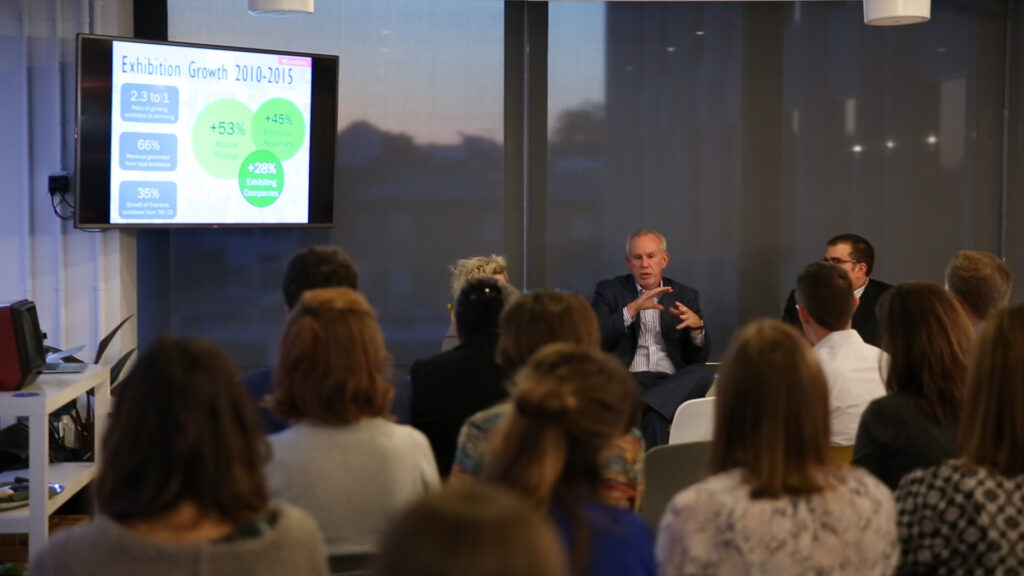Last week, we attended a panel here in DC that dived into event data analytics. It attracted us for multiple reasons: 1) data is omnipresent. While at large we are an association that hosts annual events, like the 15,000 person ACS National Meeting, our own marketing and sales team also use data in every. single. platform. From marketing automation software, to social media, to our sales forecasting. And even so, it often feels as if we’re only scratching the surface, so there were plenty of takeaways that weren’t just event specific. 2) The speakers were Joe Colangelo from Bear Analytics, a data company focused on events and associations, and their clients, Chris Brown and Michelle Kelly from the National Association of Broadcasting (NAB), who just so happen to put on a media conference that attracts over 103,000 people from 160+ countries, and who represent 19.8 billion in purchasing power. Lessons from the data they distill are lessons for us all.
What were some key takeaways that science marketers can use? There was a lot of discussion about the ‘mindset’ of a data intensive project. For starters, why do it? The panelists mentioned a number of times that once you start to dive into data, it can and will surprise you. In addition, data isn’t always just about gathering new information – some amazing, surprising detail that will change everything, – but it can also be useful to confirm suspicions and gut feelings, which can be just as important. As marketers who often have to rely on instincts, we do love when we can move forward with a concrete direction!

The NAB team also talked about a specific data set that came out of the analysis: Bear Analytics found a concrete, key year for exhibitors that was a tipping point for whether they’d sign up again. If NAB could get their registered exhibitors beyond year two, the likelihood they would stay on for the following year increased exponentially. The team had retention marketing and new exhibitor marketing plans of course, but this key stat made them realize they weren’t done with exhibitors once their very first show wrapped up, and gave them a clearer target.
On the topic of attendee acquisition, Michelle Kelly from NAB discussed more lessons: Bear Analytics found that in 2010, peak registration for attendees was 40 days out, and in 2015? It’s 63 days from the start of the conference. This kind of stat has importance in all kinds of marketing, be it direct mail or advertising. Michelle specifically singled out email marketing as a key tactic to help reach attendees during these times and bridge the gap.
One of the most interesting topics of the panel was the discussion on event personas. Personas is a word that we hear a lot, of course: from purchasing products, to developing content for the buyer’s journey, but we had not yet seen this concept for event attendees and exhibitors. Bear Analytics defined three personas for NAB: The Engaged Core, The New Entrant, and The High Hurdler, all with key characteristics powered by their behaviors around purchase and engagement. NAB then used different subject lines and content depending on what persona someone fell into. For those who hadn’t attended in three years, the High Hurdler, there was a stronger call-to-action, and the content was focused on what’s new with the event. They also tried using the name in their subject line, which outperformed launch emails from the previous year.
The team @BearAnalytics distilling 600k records into actionable marketing personas w/ @NABShow #Eventdata pic.twitter.com/VJbSgtlPim
— Marissa Maybee (@Maybs321) October 15, 2015
Now why only three personas? With a 103,000 person event, there are a lot of different industries and characteristics that could be used, making the task of defining personas incredibly difficult. But Joe Colangelo pointed out that even though they’re all from different industries, they’re behaving the same way, and that’s really what you’re after.
Finally, this is all well and good, but where does one start? Be it event data, or a social media audit? Chris Brown does contend that it depends on where you are and what state your data is currently in, but “remember that there will always be data that hasn’t been collected.” It is not a set in stone kind of process. It will evolve and inform you in ways you’re not expecting, so don’t expect a right answer. No matter the project, “your audience is telling you something. And you have to find a way to ask them questions to collect the information, anecdotally or behaviorally.”
Michelle’s advice for the group? What may sound like one small step can actually be a milestone. “Just doing the initial step to house your data in one place is huge. In our case, all the registrants over the course of however many years.” If this is the place you find yourself, – the beginning – you’re already on the right path, because, as Michelle puts it, “All data really does is make you want to more. You have to keep going.”
Thanks to Bear Analytics and the NAB speakers for presenting their information!


















